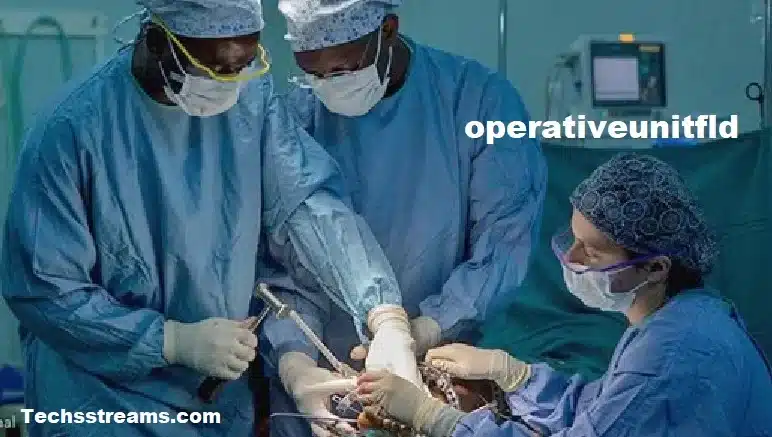
Operativeunitfld are the backbone of efficient organizational functioning across various sectors. Understanding what an operative unit is and how it functions can significantly enhance the efficiency and effectiveness of any organization. Let’s dive into the world of operative units and explore their critical role in organizational success.
Defining Operativeunitfld
An operativeunitfld is a structured group within an organization, designed to perform specific functions and achieve particular objectives. These units operate with a defined set of resources, personnel, and technologies to accomplish their goals.
Key Characteristics
Operative units typically exhibit clear goals, structured hierarchies, and specialized functions. They have characterized by their ability to focus on specific tasks within the broader organizational framework, ensuring streamlined and efficient operations.
Types of operativeunitfld
Business Operative Units
In the business world, operativeunitfld can be departments like marketing, finance, or human resources. Each unit has distinct responsibilities and works towards achieving the company’s strategic objectives.
Military Operative Units
Military operativeunitfld are specialized groups such as battalions, squadrons, or platoons. These units have meticulously organized and trained to carry out specific missions, ensuring national security and operational readiness.
Healthcare Operative Units
In healthcare, operativeunitfld include surgical teams, emergency response units, and specialized care departments. These units work cohesively to provide patient care, manage emergencies, and perform critical medical procedures.
Role of Operative Units in Organizations
Operativeunitfld enhance efficiency by focusing resources and personnel on specific tasks, thereby reducing redundancy and improving productivity. By clearly defining roles and responsibilities, operative units streamline operations, making it easier to manage workflows and achieve organizational goals.
Components of an operativeunitfld
Personnel
The personnel in an operative unit are its most crucial asset. Skilled and well-trained staff ensures that the unit can perform its functions effectively.
Resources
Resources such as funding, equipment, and materials are essential for the unit to carry out its tasks. Efficient allocation and management of these resources are vital for success.
Technology
Technology plays a significant role in modern operative units, providing tools and systems that enhance performance and efficiency.
Operational Strategies for Success
Effective operativeunitfld engage in strategic planning to set clear objectives and develop actionable plans to achieve them. This involves assessing current capabilities, identifying gaps, and outlining steps to bridge these gaps.
Using performance metrics to measure success is crucial. Key Performance Indicators (KPIs) help in monitoring progress, identifying issues, and making informed decisions.
Resource Constraints
Limited resources can hinder the performance of operativeunitfld. Efficient resource management and prioritization are essential to overcome this challenge. Staying updated with the latest technology can be challenging but is necessary for maintaining efficiency and competitiveness.
Human Factors
Human factors such as team dynamics, morale, and leadership can significantly impact the performance of an operative unit.
Technological Integration in operativeunitfld
Technology integration is crucial for modern operative units. It enhances communication, data management, and operational efficiency. Examples include project management software, communication platforms, and data analytics tools. These technologies help streamline operations and improve decision-making.
Best Practices for Managing operativeunitfld
Effective leadership is critical. Leaders should be able to inspire, motivate, and guide their teams towards achieving unit objectives. Clear and consistent communication is vital for ensuring that everyone in the unit is on the same page and working towards common goals.
Corporate Examples
Companies like Google and Amazon have operativeunitfld that are renowned for their efficiency and innovation. Their success lies in strategic planning, technological integration, and effective leadership. Elite military units like the Navy SEALs are examples of highly effective operative units. Their success is due to rigorous training, strategic planning, and cohesive teamwork.
Healthcare Examples
Hospitals like the Mayo Clinic have operative units that are leaders in medical innovation and patient care. Their success is driven by skilled personnel, cutting-edge technology, and efficient management. Future operative units will likely see increased use of artificial intelligence, automation, and advanced data analytics to enhance efficiency and decision-making.
Evolving Operational Models
Operational models will continue to evolve, with a focus on flexibility, adaptability, and continuous improvement. The impact of operative units on overall performance can be measured through various metrics such as productivity, efficiency, and financial performance.
Organizations with well-functioning operative units, like Tesla and Microsoft, demonstrate higher levels of innovation, customer satisfaction, and profitability.
Training and Development for Operative Units
Continuous training and development are essential for keeping personnel updated with the latest skills and knowledge. Effective training programs should be tailored to the specific needs of the unit, incorporating both theoretical knowledge and practical skills.
Common Misconceptions about Operative Units
One common misconception is that operativeunitfld are rigid and inflexible. In reality, successful units are adaptable and responsive to changing circumstances. Operative units are not just about hierarchy and control; they are about collaboration, innovation, and achieving collective goals.
Conclusion
In summary, operativeunitfld are critical components of any organization, driving efficiency, innovation, and success. By understanding their roles, components, and challenges, organizations can better leverage these units to achieve their strategic objectives.